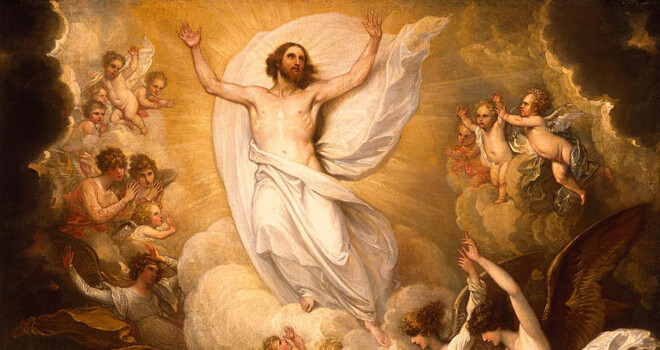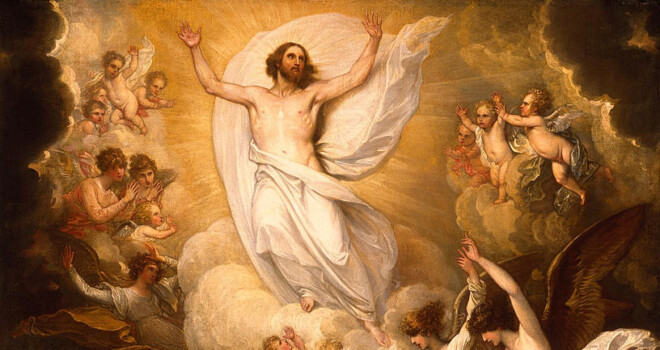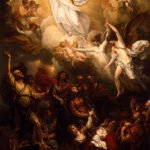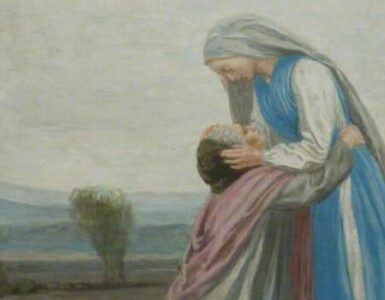Viewing and pondering sacred art, engaging in vizio divina, offers the faithful a great way to meditate more deeply on the life of Jesus Christ and the mystery of salvation. This series of articles will highlight several pieces of art related to the glorious Easter season, with specific attention to Scripture readings. Each of these pieces of art allows us to reflect on the astonishing realities of the resurrected life.
The Ascension of the Lord marks the conclusion of the Paschal Mystery. This great solemnity pulls our minds and our hearts upward as we long for full union with Jesus in glory. Still, we are reminded by the biblical record of this event, and by the sacred art that depicts it, that there is a period of time in which we live in both worlds. We are to keep to our earthly task until we “become heirs according to the hope of eternal life” (Titus 3:7).
The Gospels tell us very little about this event. Both St. Mark and St. Luke offer readers two sentences: one sentence about Jesus’ Ascension and a second sentence about the Church’s actions immediately following. It is the Acts of the Apostles, also written by St. Luke, that tells us most about this astonishing event.
Benjamin West was an American artist as well as one of the primary founders of the British Royal Academy of Art. In 1801, clearly relying on the account from the Acts of Apostles, West painted The Ascension. His masterpiece captures the sheer majesty of Jesus returning to heaven, as well as the wonder and awe that caused the Apostles and the earliest Church to worship and proclaim the Good News.
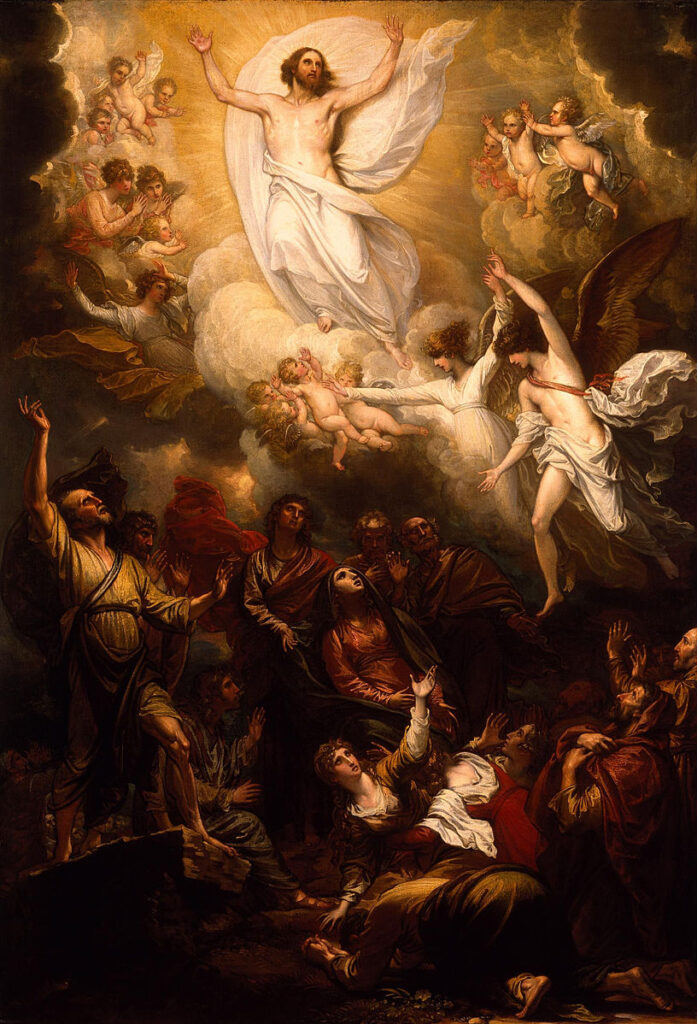
The focal point of the painting is the Ascended Christ. Here we call to mind St. Luke’s description in his Gospel: “And he led them out as far as Bethany, and lifting up his hands he blessed them. While he blessed them, he parted from them and was carried up into heaven” (Lk. 24:50-51). In this moment, the Divine Son, the Second Person of the Trinity, is returning to his original dwelling place “at the right hand of God” (Mk. 16:19). The artist depicted this reality by painting Jesus wrapped in a burst of light that seems to emanate from his divine self.
Jesus raises his hands in an act that proclaims his triumphant glory and blesses those who are near him. Here again, we can reflect on Jesus’ divinity. Do I meditate on Jesus’ divinity, his providence and power? Do I realize that he took on my human nature so that I might become a partaker of the divine nature (cf. 2 Pt. 1:4)? Do I proclaim Jesus as triumphant victor? Do I seek to be in proximity to the great Victor to receive the blessing he desires to bestow?
We also notice that the Lord’s raised hands bear the scars that resulted from being pierced by nails. In his book, Life of Christ, Ven. Fulton Sheen wrote about those pierced hands at the Ascension:
“His sacrifice being completed, as He was about to ascend to His Heavenly throne, He raised His hands bearing the imprint of nails. … The hands were raised first to heaven and then pulled downward to earth as if to draw down its blessings on men. Pierced hands best distribute benediction.”
Am I able to recall frequently that Jesus’ Paschal Mystery, the “wounds [by which] we are healed” (Is.53:5), is the ultimate source of every grace and blessing that we have ever received, or will ever receive?
The cloud on which Jesus ascends to Heaven is also worth some reflection. The Acts of Apostles tells us that “a cloud took him from their sight” after the Lord had finished teaching (Acts 1:9). This detail causes us to remember that, throughout all of salvation history, a cloud has always signified God’s sacred presence, from the desert wanderings after the exodus to the Transfiguration on Mount Tabor. Do I acknowledge God as the guiding factor of both human history and my own history?
Not quite within the cloud, but very close, are the “two men dressed in white garments” mentioned by St. Luke (Acts. 1:10). These are angels, God’s messengers, just like those mentioned in St. Luke’s account of the Resurrection. As we gaze on these two figures, their words to the Apostles reverberate in our minds: “Men of Galilee, why are you standing there looking at the sky?” (Acts 1:11). By their question, they imply that these people should be looking also to the realities of earth. How has the message of the Lord come to me and how have I responded? Have I realized that the work of the Kingdom is the necessary and immediate response to the Paschal Mystery? Am I able to find a healthy balance of gazing on the glory of the Lord in prayer and meditation, on one hand, and engaging in works of mercy and evangelization, on the other?
Below the cloud and the angels, the bottom half of the painting is also elicits extended meditation. First, we notice that this part of the painting is quite a bit darker. This might be the artist’s method of depicting the human need for divine revelation. As powerful and wonderful as human reason is, it is finite and limited. Without the aid of grace, all of us would be severely shrouded in darkness. Even the Blessed Mother, at the center of the crowd, needs grace to fully enlighten her human capacities. Do I tend to think that my own capacity for reason is sufficient for the work that I do? Do I recognize my own need for enlightenment by God’s revelation?
There are eleven Apostles along with other disciples who witnessed this event. Clearly, this is the very nascent Church. Most of the figures, gaze toward the Ascended Christ. Without a doubt, this seems to be an appropriate posture. But, these Eleven were not called to continually gaze upward. They were called to make a pilgrimage through this world, which would be informed by that heavenward gaze. This is why St. Mark tells us, “And they went out and preached everywhere, while the Lord worked with them and confirmed the message by accompanying signs” (Mk. 16:20). Is my whole life informed by my heavenward gaze? Is my first priority attaining Heaven? Do I seek to bring others into that state with me?
At the very bottom of the painting, one apostle falls prostrate in worship, reminding us of the words of St. Luke’s Gospel (cf. Lk. 24:52). The sheer power and glory of Our Blessed Lord leads a person to acknowledge his own lack of power and worth. The great paradox is that such an understanding becomes the most effective place from which to evangelize. Worship in humility causes us to proclaim the glory and greatness of the God-man. Do I prostrate myself in worship before God, physically as much as spiritually?
In these days of awaiting the Promise of the Father to be “clothed with power from on high” (Lk. 24:49), we all will do well to meditate on Benjamin West’s memorable painting. It can remind us of God’s transcendent glory as well as the mission that we have been given in this world. This piece of art, along with this solemnity, is a fantastic reminder of both dimensions of the Christian thing.
(Nota bene: West’s painting hangs in the Denver Art Museum, which is a necessary stop on a visit to the Mile-High City.)


